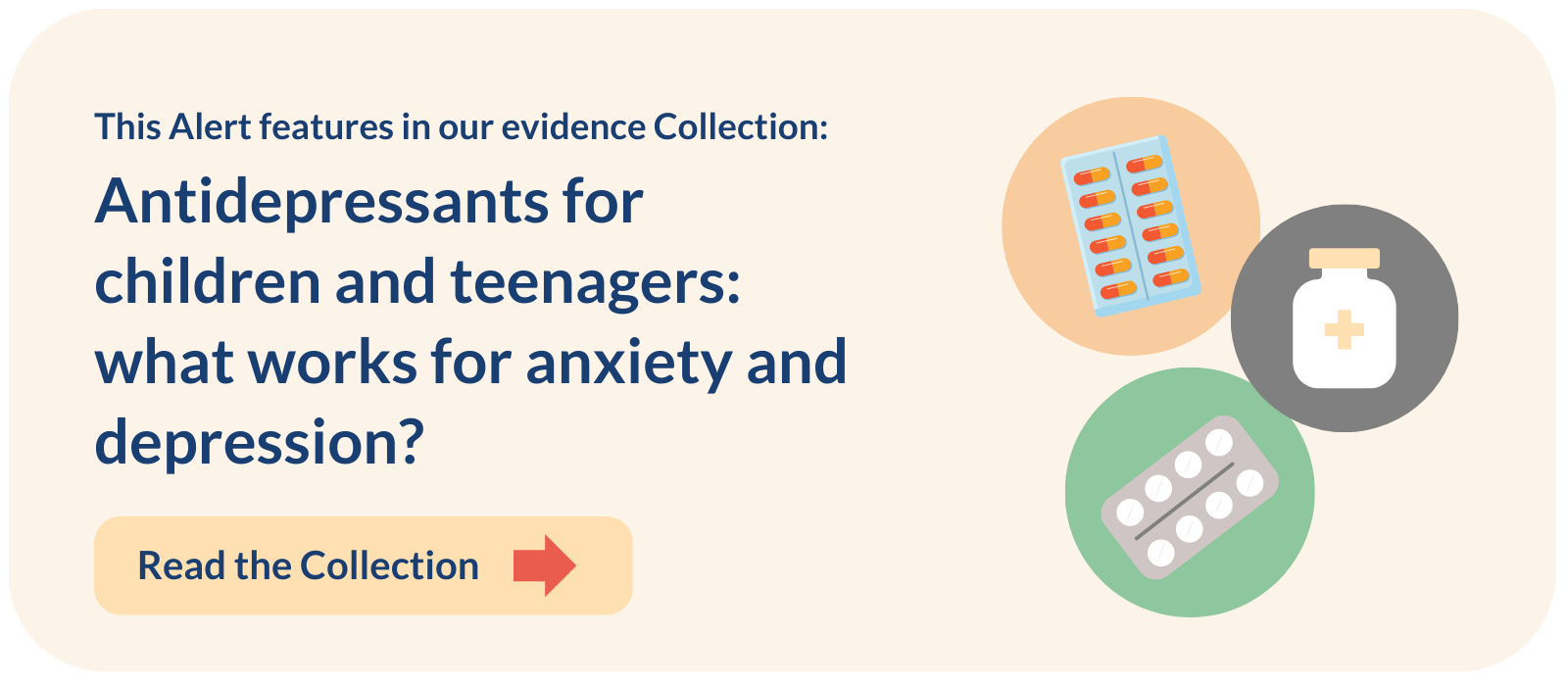Please note that this summary was posted more than 5 years ago. More recent research findings may have been published.
This is a plain English summary of an original research article. The views expressed are those of the author(s) and reviewer(s) at the time of publication.
Children and adolescents with moderate-to-severe depression are being prescribed treatments that are not backed by reliable evidence. There is insufficient data on whether treatments work and if they are safe. Unlike for adults, the best way to treat symptoms of depression in these age groups is unknown.
A review of 71 separate trials found that fluoxetine (Prozac) seems to be the best choice, either alone or combined with cognitive behavioural therapy (CBT). CBT is a talking therapy that can help people change the way they think or behave, in order to better manage problems. But most of the studies were rated as low quality, so this conclusion is uncertain.
Psychiatrists will need to continue to use their judgement and treat young people on a case-by-case basis, the study authors conclude. Treatment decisions take into account drugs’ effectiveness, and whether individual patients are likely to take them as prescribed. The possible risk of extreme side effects such as increasing suicide attempts must be considered.
Better collaboration between academia, industry and researchers is needed to produce research that analyses individual patient data.
What’s the issue?
Depressive disorders are common in children and adolescents and they increase with age. About one in 330 (0.3%) of 5-10 year olds is affected and the numbers rise to almost one in 20 (4.8%) of 17-19 year olds.
The symptoms of depression include sadness, irritability, a lack of motivation and extreme tiredness. Depression can have a more serious impact on young people’s social life and educational achievements than adults experience. It can increase risks of smoking, substance abuse, obesity and suicide.
Antidepressant drugs, talking therapies (psychotherapies) and a combination of the two are routinely used. There is little evidence to indicate which of the possible interventions is the best choice. Some clinical guidelines recommend that anti-depressants are reserved for the most serious childhood cases, or after psychotherapy has failed. But, again, evidence to support this strategy is limited.
What’s new?
Researchers reviewed the available evidence. They included 71 trials, which included a total of 9510 participants. Together, the trials assessed 16 antidepressants, seven psychotherapies and five combination therapies.
The results showed that:
- most of the studies were rated “low” to “very low” quality
- fluoxetine was the most effective option, either alone or combined with CBT
- fewer patients stopped taking fluoxetine and nefazodone than several other drugs (sertraline, imipramine and desipramine) suggesting they are more acceptable
- interpersonal therapy, which focuses on relationships with others, was the only type of talking therapy more effective than a dummy intervention such as being added to a waiting list
- antidepressants alone were not more effective than psychotherapies alone
- the drug venlafaxine was associated with an increased risk of suicidal thoughts or attempts.
Why is this important?
Current NICE guidelines recommend psychotherapies alone (such as CBT within a group) for children and adolescents with mild depression. For those with moderate to severe depression (such as the young people in this study), NICE recommends more intense psychological therapies (such as individual CBT) as initial treatment. However, the guidelines state that combined therapy (fluoxetine and psychological therapy) is an alternative.
The results of this study broadly support that approach. The research found that fluoxetine (with or without CBT) gave the best results. But the report also noted that evidence is based on relatively poor-quality studies.
What’s next?
The findings suggest that fluoxetine (alone or in combination with CBT) might be the best option for treating children and adolescents with severe depression.
This is the most comprehensive review to date. But it is important to interpret the findings with caution. Results could vary from individual to individual. Patients, carers and clinicians should continue to carefully balance the potential benefits of treatments with how acceptable they are, and the risk of suicide.
Few new studies into the use of these treatments in children and adolescents are being carried out. This means that new data which could test this conclusion, is lacking.
You may be interested to read
The full paper: Zhou X, and others. Comparative efficacy and acceptability of antidepressants, psychotherapies, and their combination for acute treatment of children and adolescents with depressive disorder: a systematic review and network meta-analysis. Lancet Psychiatry 2020; 7: 581-601
A review of evidence on antidepressants: Cipriani A, and others. Comparative efficacy and tolerability of antidepressants for major depressive disorder in children and adolescents: a network meta-analysis. Lancet 2016; 388: 881-890
A review of evidence on psychotherapies: Zhou X, and others. Comparative efficacy and acceptability of psychotherapies for depression in children and adolescents: A systematic review and network meta-analysis. World Psychiatry 2015; 14: 207-222
Funding: This research was supported by the NIHR Oxford Cognitive Health Clinical Research Facility, by an NIHR Research Professorship, by the NIHR Applied Research Collaboration Oxford and Thames Valley, and by the NIHR Oxford Health Biomedical Research Centre.
Conflicts of Interest: Study authors report fees and grants from various pharmaceutical companies, outside of this research.
Disclaimer: Summaries on NIHR Evidence are not a substitute for professional medical advice. They provide information about research which is funded or supported by the NIHR. Please note that the views expressed are those of the author(s) and reviewer(s) and not necessarily those of the NHS, the NIHR or the Department of Health and Social Care.
NIHR Evidence is covered by the creative commons, CC-BY licence. Written content and infographics may be freely reproduced provided that suitable acknowledgement is made. Note, this licence excludes comments and images made by third parties, audiovisual content, and linked content on other websites.
